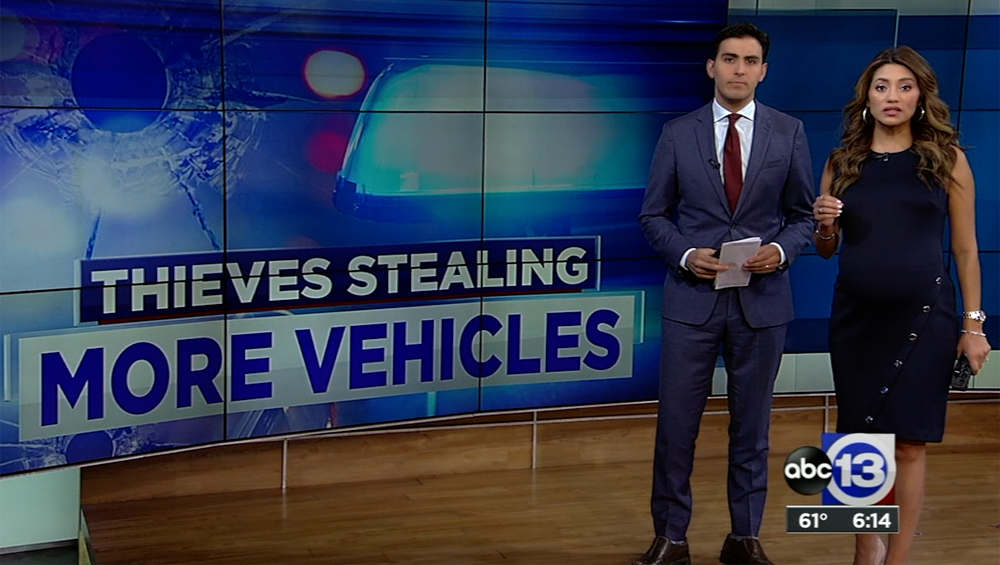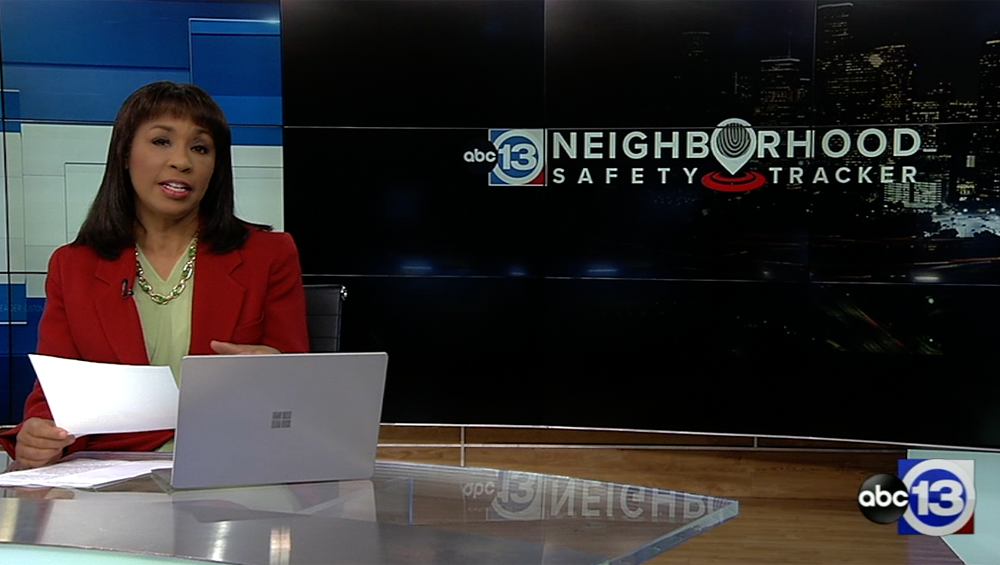For ABC Stations, Collecting Crime Data Charts A Path To Good News
In the area around NRG Park, the stadium that hosts Houston Texans home games as well as other sporting events and conventions throughout the year, car-part theft between October 2021 and October 2022 grew four times higher compared to the rate of such crimes in 2019.
The thieves’ primary focus has been catalytic converters, which are partly made with some precious metals, and the car-part stealing spike there gave the neighborhood a dubious honor. While car-part theft rose three times across all of Houston during that same period, the quadrupling of the class E felony around NRG Park meant the area’s increased rate of that crime was the highest in the city.
KTRK, an ABC Owned Station, devoted a segment to the issue, which included tips on the ways residents can better protect their car’s catalytic converters. The package also featured data supporting its report that car part theft was the fastest-rising crime in Houston and that criminal specialists were targeting visitors to NRG Park. The areas that saw the second- and third-highest rises in car-part thievery were also places heavily trafficked by travelers: the Bush Airport area and the neighborhood around the city’s Northwest Mall.
All this specified reporting was sparked by the launch of the Neighborhood Safety Tracker, an ABC Owned Stations interactive website and app that collects and presents public record data from local police departments. Viewers in the eight cities served by ABC Owned Stations can locate their local news team’s Neighborhood Safety Tracker on their respective websites and find, according to a company statement, “up-to-date crime and safety information tailored to each individual market.” The tool, which was rolled out across all of the ABC Owned Stations in January, is also fueling impactful data journalism initiatives in those markets, with the potential to change how safety reporting is done.
 In addition to the car-part theft story — which was not only data-driven but also solutions-oriented, two reporting approaches that are gaining popularity — KTRK also leveraged the Neighborhood Safety Tracker to produce a segment about one Houston neighborhood’s dramatic drop in crime.
In addition to the car-part theft story — which was not only data-driven but also solutions-oriented, two reporting approaches that are gaining popularity — KTRK also leveraged the Neighborhood Safety Tracker to produce a segment about one Houston neighborhood’s dramatic drop in crime.

Wendy Granato
Wendy Granato, KTRK president and GM, says for many years the Greenspoint section of the city had “gotten this reputation of being riddled with crime, so much that it was nicknamed ‘Gunspoint.’” But according to data that KTRK gleaned from the tracker, murders in Greenspoint had dropped 53% from the start of 2021 through October 2022. Car thefts, robberies and sex assaults were also down, while the burglary rate remained flat.
Instead of presenting yet another story on all the crime seemingly going on in Greenspoint, KTRK’s news team decided to change course. Granato says producers and reporters sought to find out “what has the community been doing, what efforts have been made and is it still justified for that area to be deemed ‘Gunspoint’?”
“Well low and behold, it’s not,” Granato says. “Things in Greenspoint have gotten so much better and it has become one of the safer areas [in Houston]. And then we went in and dug into how.”
What emerged was an inspiring story of how business leaders, pastors and youth and wellness advocates all worked together to turn the neighborhood around. Granato sees news stories like the one about Greenspoint itself as a form of “advocacy.”
“We got such an amazing response from that community thanking us,” Granato says. She volunteers that KTRK heard remarks like, “I thought you only reported on the negative, but here you took a deeper look and actually reported on something that was positive.”
This kind of news, rooted in the Neighborhood Safety Tracker data, flies in the face of the “if it bleeds, it leads” approach, which has been roundly criticized for years due to its potential negative effects on viewer psychology and for helping to proliferate neighborhood (and racial) stereotypes.
Granato says the Neighborhood Safety Tracker is so easy to use that its integration into newsroom workflow has been seamless. In the future, she believes KTRK will find ways to use the Neighborhood Safety Tracker so the station’s news team can be “more interactive” with viewers. For now, she says the Neighborhood Safety Tracker data already buoys the majority of crime stories KTRK produces.
“Data don’t lie,” Granato says. “It’s changed everything for us.”
“One of the most common requests for help we get from our newsrooms is in trying to wrangle and make sense of public safety data and crime information, and really get at questions for the viewer that put that in context,” says John Kelly, director of data journalism at ABC Owned Stations. “When we rely on human sources for that, it puts us in a position sometimes of being open to those sources’ interpretations or recency bias.”
The Neighborhood Safety Tracker, thus, is a tool that helps mitigate this problem, which leads to potential reporting inaccuracies or misrepresentations of trends and events. It allows reporters to establish context around crime happenings, Kelly says, which is difficult for viewers to wrap their heads around, especially those who live in areas that have unfortunately high crime rates.
 “So [we’ve] put that in comparison to the same risk for things that most of us can relate to,” Kelly says. Giving a hypothetical, he says reporters can present facts in such a way that sounds like, “You’re five times more likely to lose a family member to a car accident this year than your risk” of being a victim of some violent crime, such as murder. “And then we can add layers [to the reporting], like geography and things like that,” Kelly says.
“So [we’ve] put that in comparison to the same risk for things that most of us can relate to,” Kelly says. Giving a hypothetical, he says reporters can present facts in such a way that sounds like, “You’re five times more likely to lose a family member to a car accident this year than your risk” of being a victim of some violent crime, such as murder. “And then we can add layers [to the reporting], like geography and things like that,” Kelly says.
But also, Kelly continues, because viewers can view that data themselves, “There’s a segment of this that’s valuable to the community, to answer these questions that they’re often asking or that they’re often getting — maybe not purposefully — [a] misperception about.”
Kelly, who’s been building the data journalism team and its capabilities at ABC Owned Stations for three years, says the company is devoting so many resources to such initiatives in large part because it generates transparency and, by extension, builds viewer trust, the decline of which across the industry has been well documented. It took much of 2021 to develop the Neighborhood Safety Tracker — with coders and other personnel, who maintained other responsibilities as well — but Kelly says the project was not overly challenging to produce once the company had committed to it.
The idea for the Neighborhood Safety Tracker manifested from a series of conversations between Kelly, his team from across the company’s markets and Chad Matthews, president of ABC Owned Stations, who ultimately greenlit the project. Since the Neighborhood Safety Tracker’s launch, Kelly says the eight newsrooms with access have used it “heavily,” including to produce other market-focused stories about catalytic-converter thefts, a nationwide concern.
Granato says KTRK’s reporting about the crimes has led to increased community awareness and even arrests. Using the Neighborhood Safety Tracker to build those stories made all the difference.
“For the viewer it just means we’re working our butt off on your behalf,” Granato says. “We’re trying to inform you and make your life better.”
































Comments (1)
NowACurmudgeon says:
April 11, 2023 at 8:41 am
There is also crimewatch.com